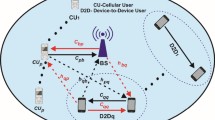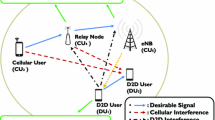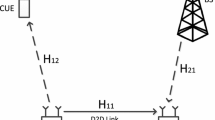Abstract
Device-to-device multicast (D2MD) communications enable dissemination of messages directly from one user equipment (UE) to a group of D2D UEs (DUEs) located in close proximity, instead of routing via the base station. The challenges of D2MD arise from the interference to and from in-band cellular UEs (CUEs) due to frequency reuse, and the low data transmission rate constrained by the worst channel quality. To improve the overall system capacity, a novel interference coordination scheme and an adaptive demodulation mapping scheme (ADMS) based on rateless encoding technique is proposed. Firstly, a new interference limited area control scheme that reduces the interference from CUEs to each DUE is proposed. In the proposed scheme, the DUEs share same resource with the CUEs out of the interference limited area. Secondly, the ADMS working principle is described. In ADMS, the bits are modulated by a high level modulation and coding scheme (MCS), and each DUE can adaptively select one MCS level to demodulate bits according to the channel state information. Finally, the expressions of two performance metrics are derived, namely D2MD system delay and energy consumption, and a distance minimization problem (DMP) with attenuation function to achieve the tradeoff between the two metrics is formulated. From the simulation results, it is confirmed that the proposed schemes improve the performance of the hybrid system compared to the conventional ways. In addition, by controlling the introduced parameter, DMP can balance the tradeoff between the two metrics effectively.











Similar content being viewed by others
References
Malandrion, F., Casetti, C., & Chiasserini, C.-F. (2014). Toward D2D-enhanced heterogeneous networks. IEEE Transactions on Wireless Communications, 52(11), 94–100.
Yin, R., Zhong, C., Yu, G., & Zhang, Z. (2016). Joint spectrum and power allocation for D2D communications underlaying cellular networks. IEEE Transactions on Vehicular Technology, 65(4), 2182–2195.
Ni, Y., Jin, S., Xu, W., & Wang, Y. (2016). Beamforming and interference cancellation for D2D communication underlaying cellular networks. IEEE Transactions on Vehicular Communications, 64(2), 832–846.
Doppler, K., Yu, C.-H., Ribeiro, C. B., & Jänis, P. (2010). Mode selection for device-to-device communication underlaying an LTE-advanced network. In Proceedings of IEEE wireless communications and networking conference (WCNC 2010) (pp. 1–6).
Li, Y., Zhang, L., Tan, X., & Cao, B. (2016). An advanced spectrum allocation algorithm for the across-cell D2D communication in LTE network with higher throughput. China Communications, 13(4), 30–37.
Liu, Y. (2016). Optimal mode selection in D2D-enabled multibase station systems. IEEE Communications Letter, 20(3), 470–473.
Kim, J., Kim, S., Bang, J., & Hong, D. (2016). Adaptive mode selection in D2D communications considering the bursty traffic model. IEEE Communications Letter, 20(4), 712–715.
Mumtaz, S., Mohammed, K., Huq, S., Rodriguez, J., & Frascolla, V. (2016). Energy-efficient interference management in LTE-D2D communication. IET Signal Processing, 10(3), 197–202.
Wang, H., & Chu, X. (2012). Distance-constrained resource-sharing criteria for device-to-device communications underlaying cellular networks. IEEE Electronics letters, 48(9), 528–530.
Phunchongharn, P., Ekram, H., & Kim, D. (2013). Resource allocation for device-to-device communications underlaying LTE-advanced networks. IEEE Wireless Communications, 20(4), 91–100.
Lei, L., Zhong, Z., Lin, C., & Shen, X. (2012). Operator controlled device-to-device communications in LTE-advanced networks. IEEE Wireless Communications, 19(3), 96–104.
GPP TR 22.803 V12.2.0. (2013). Technical specification group services and system aspects, Feasibility Study for Proximity Services (ProSe).
Yang, Z., & Zhao, Y. P. (2012). Resource allocation for scalable video multicast over OFDMA systems. IEICE Transactions on Communications, E95-B(9), 2948–2951.
Gong, W., & Wang, X. X. (2015). Joint user association and resource allocation of device-to-device communication in small cell networks. KSII Transactions on Internet and Information Systems, 9(1), 15–24.
Deng, H., Tao, X. M., Ge, N., & Lu, J. (2012). Joint mode selection and resource allocation for cellular controlled short-range communication in OFDMA networks. IEICE Transactions on Communications, E95-B(3), 1023–1026.
Min, H., Lee, J., Park, S., & Hong, D. (2011). Capacity enhancement using an interference limited area for device-to-device uplink underlaying cellular networks. IEEE Transactions on Wireless Communications, 10(1), 3995–4000.
Du, Y., Sun, L., & Ma, N. (2004). Method and system for peer-to-peer communication management in wireless communication networks, US Patent Nos. 7 308 266.
Doppler, K., Rinne, M. P., Wijting, C., Ribeiro, C. B., & Hugl, K. (2009). Device-to-device communication as an underlay to LTE-advanced networks. IEEE Communication Magazine, 47(12), 29–42.
Gopala, P., & Hesham, E. (2005). On the throughput-delay tradeoff in cellular multicast. In Proceedings of IEEE international conference on wireless networks, communications and mobile computing (pp. 1401–1405).
Ge, W., Zhang, J., & Shen, S. (2007). A cross-layer design approach to multicast in wireless networks. IEEE Transactions on Wireless Communications, 6(3), 1063–1071.
Low, T., Pun, M., Hong, Y., et al. (2010). Optimized opportunistic multicast scheduling (OMS) over wireless cellular networks. IEEE Transactions on Wireless Communications, 9(2), 791–801.
Quang, L., Tho, L., & Ho, Q. (2010). Opportunistic multicast scheduling with erasure-correction coding over wireless channels. In Proceedings of IEEE international conference on communications (ICC) (pp. 1–5).
Brown, J. D., Pasupathy, S., & Plataniotis, K. N. (2006). Adaptive demodulation using rateless erasure codes. IEEE Transactions on Communications, 54(9), 1574–1585.
Mackay, D. (2005). Fountain codes. IET Transactions on Communications, 152(6), 1062–1068.
Luby, M., Watson, M., & Gasiba, T., et al. (2006). Raptor codes for reliable download delivery in wireless broadcast systems. In Proceedings of IEEE consumer communications and networking conference (CCNC) (pp. 192–197).
ETSI 30.03. (1998). Selection procedures for the choice of radio transmission technologies for UMTS, TR 101 112, v3.2.0.
Acknowledgments
This work was supported by the National High-Tech R&D Program (863 Program 2015AA01A705).
Author information
Authors and Affiliations
Corresponding author
Appendix
Appendix
Denote the CDF of the received SNR as \(F_{\gamma } (\gamma )\). By Eq. 3, the authors get \(\left| h \right|^{2} = {{N_{0} \gamma } \mathord{\left/ {\vphantom {{N_{0} \gamma } P}} \right. \kern-0pt} P}\). There must be \(F_{{\left| h \right|^{2} }} (x) = P_{r} \{ {{N_{0} \gamma } \mathord{\left/ {\vphantom {{N_{0} \gamma } P}} \right. \kern-0pt} P} \le x\} = P_{r} \{ \gamma \le {{Px} \mathord{\left/ {\vphantom {{Px} {N_{0} }}} \right. \kern-0pt} {N_{0} }}\} = F_{\gamma } ({{Px} \mathord{\left/ {\vphantom {{Px} {N_{0} }}} \right. \kern-0pt} {N_{0} }})\).
Let \(t = {{Px} \mathord{\left/ {\vphantom {{Px} {N_{0} }}} \right. \kern-0pt} {N_{0} }}\), and the authors can get \(F_{\gamma } (t) = F_{{\left| h \right|^{2} }} ({{N_{0} t} \mathord{\left/ {\vphantom {{N_{0} t} P}} \right. \kern-0pt} P})\). Thus, \(p_{{m_{i} }}\) can be given by
Rights and permissions
About this article
Cite this article
Wang, D., Wang, W., Wang, X. et al. Interference Cancellation and Adaptive Demodulation Mapping Schemes for Device-to-Device Multicast Uplink Underlaying Cellular Networks. Wireless Pers Commun 95, 891–913 (2017). https://doi.org/10.1007/s11277-016-3804-9
Published:
Issue Date:
DOI: https://doi.org/10.1007/s11277-016-3804-9




